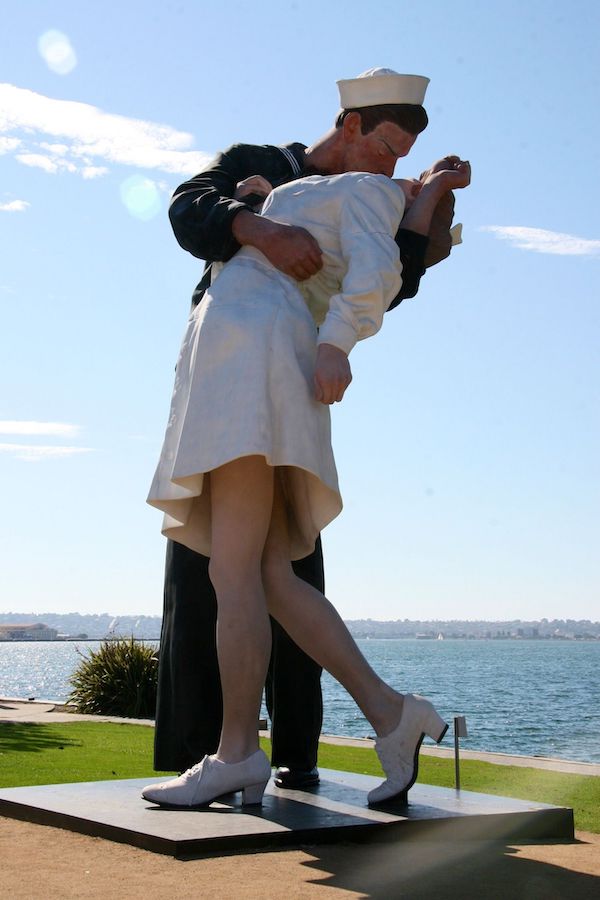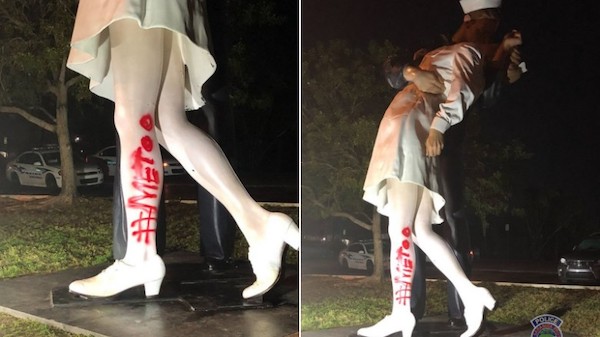Your cart is currently empty!
CURFEW

You know the photo. Times Square. 1945. V-Day. A male sailor hugging and kissing a female nurse in fervent joy over the end of World War II. An immense sculpture of the kiss seen ‘round the world, Unconditional Surrender, would later settle in Sarasota, Florida.
In 2019, a day after the veteran in the photo passed, the statue was spray-painted “#MeToo.” The nurse, Greta Friedman, had said in a 2005 interview that the kiss wasn’t consensual. “Suddenly, I was grabbed by a sailor,” she reminisced to the Veterans History Project. Kisser George Mendonsa offered a similar recollection: “I had a few drinks, and it was just plain instinct, I guess. I just grabbed her.”
#MeToo sprayed on Unconditional Surrender. Trump’s star on the Walk of Fame defaced with a tiny wall and guard tower. “Vandals” (reporters’ words) covering the hands of the Christopher Columbus monument in Central Park with red paint and graffiti on its base: “Hate will not be tolerated.” All were old tributes battling new ideas.

But then there were protestors in Durham, NC, chanting “No K.K.K., no fascist U.S.A.,” lassoing a rope around a Confederate soldier’s neck, and pulling. Perhaps sensing the writing on the plinth, several municipalities removed monuments dedicated to the Confederate States of America; Maryland and New Orleans extracted theirs in the middle of the night, without public announcement.
That’s the real emergency. Deleting evidence of an event only allows it to happen again. Because it’s not removal, it’s repression, and the unconscious forces that gave rise to it initially are still hibernating. Removing a monument is like removing a mushroom, the network of subterranean mycelia remain undisturbed, waiting for the next storm to bloom.
Anyone doubting this should look at, yes, Obama and Trump, but also the vitriol, on both sides, regarding those Confederate statues—it was, once again, American vs. American. For both Americas, the monuments are monuments to something else: on one side, racism; on the other, whites fearing a loss of identity. Removing symbols doesn’t solve either issue. And while all Americans are obsessed with beauty, we need to appreciate the importance of scars. We need them as reminders that something traumatic happened here. History hurts.
This does not mean, however, that each time you and your African American child visit the park you need to be accosted with a symbolic reminder of slavery. The answer to problematic art isn’t removal but reinterpretation. Artists created the statues, artists should be the ones who respond to them.
Before most monuments see their first pigeon poop, they’re one of many submitted designs. Committees whittle down the submissions, votes occur, debates happen, and, finally, a project is chosen. We could echo the process across time: instead of removing uncomfortable monuments, give artists the opportunity to reimagine them.
Another generation put up the art. Our generation should be allowed to respond.
Monument Lab, in Philadelphia, plays with this theme. As they point out, “In a city that boasts hundreds of monuments to founding Philadelphians and esteemed visitors, only two publicly sanctioned, full-figured statues are dedicated to historic women: French heroine Joan of Arc and Bostonian Quaker Mary Dyer.” Multimedia artist Sharon Hayes sought to put sisters in the city of brotherly love—not by tearing down the hundreds of monuments with XY chromosomes, but via If They Should Ask: nine crafted concrete pedestals (“based on those on which statues of historic men currently stand across the city”), scaled them to half-size, and clustered them together in the middle of Rittenhouse Square. Chiseled on the plinths: “On this site there should be a statue to… ” followed by the names of female Philadelphians who “have contributed to the social, cultural, political and economic life of the city.”

Which chisels out another argument for non-erasure. Removing Trump’s star on the Walk of Fame would allow tourists to forget it. Putting up a fence and guard tower prompts thought. I’m going to guess that many who decried the vandalizing of Unconditional Surrender barely registered its existence until it was desecrated. Monuments need to be continually re-edited as reminders.
The theme of this issue is “State of Emergency,” and the opposite of emergency is complacency. Spraying, painting, building makes you notice. If you topple a statue, put up another statue of people toppling that statue.
If that’s not an option, if there’s an emergency that can’t wait, vandalize the monuments. Paint their hands with blood, tag their legs with the sexual assault blemishes they deserve. Just don’t remove them. You can’t bear witness to an empty pedestal. Unconditional Surrender was a monument to Allied victory; now let it be a monument to the fight against sexual assault. When we reach the V-Day over that, then the statue can be toppled.